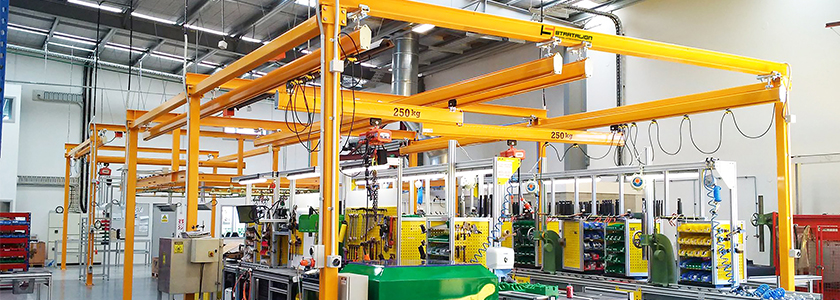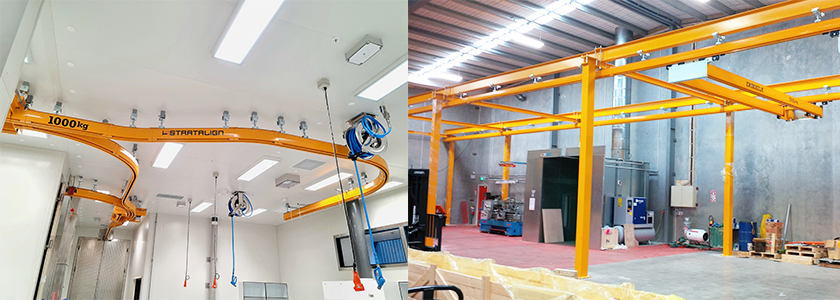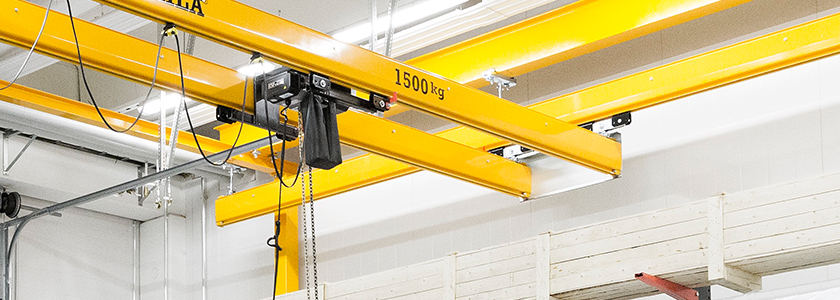Why pay for capability and capacity that you don’t need? The best material handling equipment is simply that which is built for the task at hand. Case in point: light crane systems.
In light crane systems, NZ businesses have a versatile, cost-effective and efficient solution to their material handling challenges.
In this guide we tell you all you need to know about light and modular crane systems, to help you understand whether a light crane solution is the right choice for you.
What is a light crane system?
While the term “light crane” can be used to describe a number of different lifting devices, including lightweight jib and davit cranes, “light crane system” most commonly refers to the overhead or gantry cranes used above workstations – AKA workstation light crane systems.
Light crane systems are user-friendly, ergonomic gantry cranes capable of lifting and shifting loads of up to 2000kg. They are designed to enable workers to perform material handling tasks quickly and safely within a dedicated area.
Light crane systems are usually made up of the following components:
- Tracks/rails: The runways connected to your building (ceiling/wall-mounted cranes) or columns (freestanding cranes) that allow the bridge to move horizontally.
- Bridge: The horizontal beam that moves along the tracks/rails. It can be a single or double girder bridge depending on load requirements.
- Columns/pillars: Freestanding light crane systems will elevate the crane with four or more columns or pillars.
- Trolley: The mechanism that rolls along the bridge and holds the hoist.
- Hoist: The lifting mechanism attached to the trolley. They are most commonly electric, but can also be manual or pneumatic.
- Control system: A pendant or remote that allows an operator to control the crane.
Advantages of a light crane system
Why choose a light crane solution? In certain situations these systems will offer a wealth of benefits:
- Versatile: A light crane system can handle a variety of lifts and can be used in a variety of situations, including in factories, workshops and warehouses.
- Cost-effective: Featuring simpler designs and less material, light crane systems can be a far cheaper option than a heavy duty alternative.
- Easy to use: It only takes a small amount of time and training for an operator to become comfortable with using a light crane system.
- Configurable: Modular crane systems are easily configured to your needs. You can also expand the crane’s footprint and capacity into the future.
- Safe: Designed to enhance workplace safety by reducing the need for manual lifting and handling.
Light crane system considerations
When deciding on the best light crane solution for your situation, consider the following factors:
- Load capacity: How much weight must your light crane system be capable of lifting?
- Span and footprint: How far do you need to move loads? The span of your space can also determine whether you install a freestanding or ceiling/wall-mounted crane.
- Lift height: Consider your ceiling height, the dimensions of the loads you’ll be lifting, and how far you’ll need to elevate them off the ground.
- Duty cycle: Select a light crane system that can handle the workload you’ll throw at it.
- Environmental conditions: Consider environmental factors that your light crane system will be exposed to, such as heat, moisture and weather.
Helping New Zealand manufacturers safely solve their lifting challenges with the best local and global solutions
At Stratalign we’ve spent years helping Kiwi businesses identify and secure the lifting equipment they need. Our team has the knowledge and expertise you need to identify the ideal light crane system for your situation – the type that can make your business safer, more efficient and more productive.
We offer a complete range of light cranes, all of which are certified to AS 1418.1.




